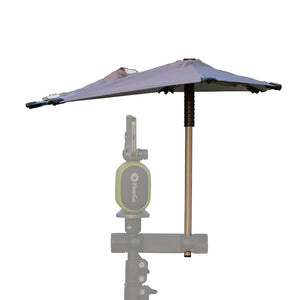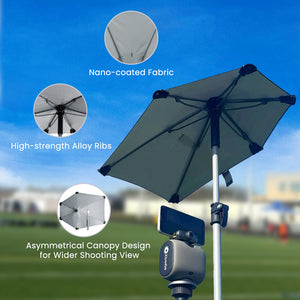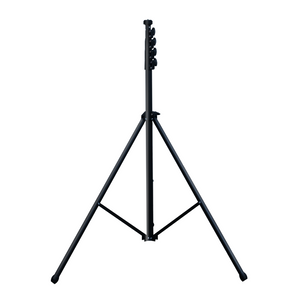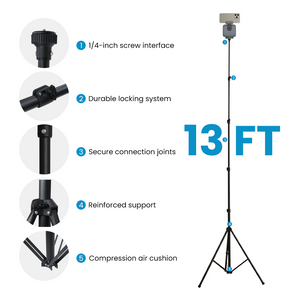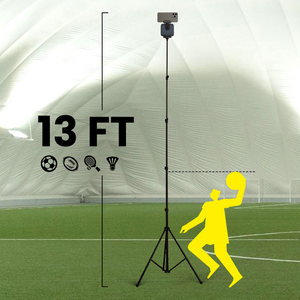XbotGo Chameleon AI Sports Camera
Hockey Stats Abbreviations: Quick Guide to Every Stat on the Sheet
You're watching the game with friends when someone asks, "What's his plus-minus?" You nod knowingly while secretly wondering what those numbers actually mean. If you've ever felt lost looking at a hockey stat sheet, you're not alone.
Essential Player Statistics
Understanding player statistics starts with the basics. These fundamental numbers tell the story of individual performance on the ice.
Scoring Stats (G, A, PTS)
G (Goals) counts every time a player puts the puck in the net. Simple enough, right? The player who last touched the puck before it crosses the goal line gets credit.
A (Assists) recognizes the teamwork in hockey. Up to two players can earn assists on each goal - these are the last two teammates who touched the puck before the goal scorer. If the opposing team gains possession between touches, no assists are awarded.
PTS (Points) adds goals and assists together. A player with 25 goals and 40 assists has 65 points. According to ESPN's NHL statistics glossary, points provide the most common measure of offensive production.
Performance Metrics (+/-, SOG, SH%)
+/- (Plus-Minus) might be hockey's most debated stat. You get a plus (+1) when you're on ice for an even-strength or short-handed goal for your team. You get a minus (-1) for even-strength or short-handed goals against. Power play goals don't affect this rating.
SOG (Shots on Goal) tracks shots that would go in the net if the goalie didn't stop them. Blocked shots and misses don't count. Research from Natural Stat Trick shows average NHL players generate 2-3 shots per game.
SH% (Shooting Percentage) reveals efficiency. Divide goals by shots on goal. If you score 10 goals on 100 shots, that's a 10% shooting percentage. League average hovers around 9-10% for forwards.
Time and Usage Stats (TOI, SHFT)
TOI (Time on Ice) shows total minutes and seconds played. Top players often exceed 20 minutes per game, while fourth-liners might see 8-10 minutes.
SHFT (Shifts) counts how many times a player takes the ice. Average shifts last 45 seconds. More shifts can indicate coach trust and player conditioning.
Goaltender Statistics Decoded
Goalie stats require their own category because the position demands unique measurements.
Save Statistics (SV%, GA, GAA)
SV% (Save Percentage) might be the most important goalie stat. It's saves divided by total shots faced. A .920 save percentage means stopping 92 of every 100 shots. According to NHL statistics, elite goalies maintain save percentages above .915.
GA (Goals Against) simply counts goals allowed. This raw number needs context from games played and shots faced.
GAA (Goals Against Average) provides that context. Take total goals allowed, divide by minutes played, then multiply by 60. A 2.50 GAA means allowing 2.5 goals per 60 minutes on average.
Performance Records (W, L, SO)
W (Wins) credits the goalie on ice when the game-winning goal is scored. If you're pulled for an extra attacker immediately before your team scores the winner, you still get the win.
L (Losses) works the same way - you're charged with the loss if you're on ice (or just pulled) when the opponent scores the game-winner.
SO (Shutouts) celebrates perfection. You must play the entire game and allow zero goals. Two goalies can't share a shutout.
Advanced Goalie Metrics
Modern analysis includes additional measurements. GSAA (Goals Saved Above Average) compares a goalie's performance to league average. HDSV% (High-Danger Save Percentage) focuses on stops from the most dangerous scoring areas.
Team Statistics Overview
Team stats help evaluate overall performance and standings position.
Standings Stats (GP, W, L, OTL, PTS)
GP (Games Played) tracks total contests. NHL teams play 82 regular season games.
W-L-OTL represents Wins-Losses-Overtime/Shootout Losses. The three-number format replaced the old Win-Loss-Tie system after the NHL eliminated ties.
PTS (Points) determines standings. Teams earn:
- 2 points for any win
- 1 point for overtime or shootout loss
- 0 points for regulation loss
Offensive and Defensive Stats (GF, GA, PP%)
GF (Goals For) and GA (Goals Against) track total team scoring. The difference between these creates goal differential, a key indicator of team strength.
PP% (Power Play Percentage) measures special teams effectiveness. Divide power play goals by opportunities. A 20% power play scores once every five chances.
PK% (Penalty Kill Percentage) flips the script. This shows the percentage of penalties killed successfully. Elite penalty kills operate above 85%.
Advanced Analytics Abbreviations
These newer stats dig deeper into performance patterns.
Possession Stats (CF%, FF%, xGF%)
CF% (Corsi For Percentage) tracks shot attempt share. If your team attempts 60 shots while opponents attempt 40 when you're on ice, that's a 60% Corsi.
FF% (Fenwick For Percentage) works like Corsi but excludes blocked shots. Some analysts prefer Fenwick because it only counts shots reaching the goal.
xGF% (Expected Goals For Percentage) weighs shot quality. A point-blank chance counts more than a shot from the blue line. This helps identify teams getting quality chances versus just volume.
Luck Indicators (PDO, SPSV%)
PDO adds shooting percentage and save percentage. It should hover around 100 (technically 1.000). A team with 102 PDO might be lucky; one at 98 might be due for better results.
SPSV% (Shooting Plus Save Percentage) serves the same purpose as PDO - identifying potential regression to the mean.
Context and Limitations
Remember these limitations with advanced stats:
- Small sample sizes create wild swings
- Team systems affect individual numbers
- Quality of competition matters
- Zone starts influence results
Penalty and Special Situation Stats
Special teams and discipline metrics reveal crucial game management aspects.
Penalty Minutes (PIM) and Types
PIM (Penalties in Minutes) totals all penalty time assessed, not served. A minor penalty adds 2 minutes, majors add 5, misconducts add 10. Multiple experts confirm PIM indicates playing style - high numbers suggest physical play, low numbers indicate discipline.
Power Play Statistics
PPG (Power Play Goals) counts goals scored with the man advantage. PPA (Power Play Assists) tracks helpers on those goals. PPP (Power Play Points) combines both.
Power play time gets tracked separately as PPTOI (Power Play Time on Ice) to show which players run the man advantage.
Short-Handed Situations
SHG (Short-Handed Goals) and SHA (Short-Handed Assists) credit aggressive penalty killing. These momentum-shifting plays often decide games.
SHTOI (Short-Handed Time on Ice) identifies primary penalty killers.
Making Stats Work for You
Understanding hockey statistics enhances your viewing experience and deepens game appreciation. Start with basics like goals, assists, and save percentage. Build toward advanced metrics as comfort grows.
Watch for these stats during your next game:
- Track a player's ice time to gauge coach confidence
- Notice plus-minus swings during momentum shifts
- Compare save percentages when goalies face similar shot volumes
- Observe how penalties affect possession stats
Remember, statistics tell part of the story, not everything. They work best when combined with watching games and understanding context. Even NHL teams that rely heavily on analytics still value traditional scouting and the "eye test."
The next time someone mentions Corsi or questions a player's PDO, you'll understand exactly what they mean. More importantly, you'll know how to use these tools to better appreciate the incredible sport of hockey.
XbotGo Chameleon AI Sports Camera
Capture every moment with AI-powered tracking. Perfect for coaches, parents, and athletes who want seamless footage without manual filming.







 Soccer
Soccer Basketball
Basketball Ice Hockey
Ice Hockey Rugby
Rugby










